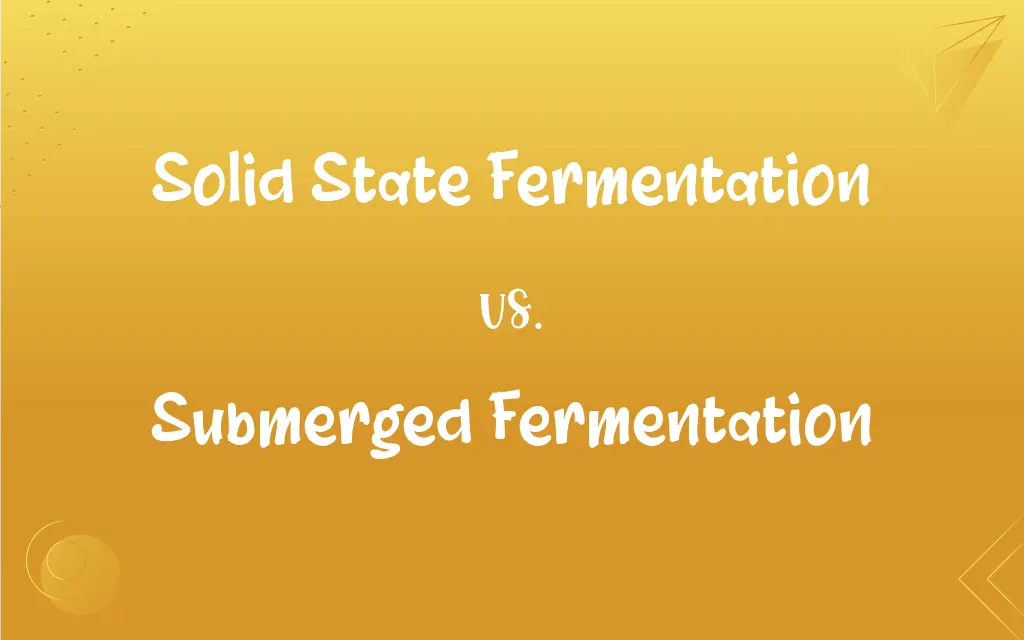Solid State Fermentation vs. Submerged Fermentation: What's the Difference?
Edited by Aimie Carlson || By Janet White || Published on January 20, 2024
Solid state fermentation involves microbial growth on a solid substrate without free water, while submerged fermentation involves microbes in a liquid medium.

Key Differences
Solid state fermentation (SSF) is characterized by the growth of microorganisms on solid materials without free-flowing water. Submerged fermentation (SmF), conversely, involves microorganisms growing in a liquid medium, often in a broth-like environment. Each method offers unique advantages depending on the desired product and process.
SSF is often used in the production of fermented foods, enzymes, and bioactive compounds, utilizing agricultural wastes or specific substrates. SmF is widely applied in the production of antibiotics, organic acids, and biofuels, leveraging the controlled conditions of liquid cultures. Both methods play crucial roles in industrial biotechnology.
In SSF, the lack of free water can lead to higher product concentration and enhanced stability. SmF typically allows for easier control of environmental conditions like pH and temperature. These differences impact the efficiency and quality of the fermentation products.
SSF often requires less energy and water, making it more environmentally sustainable. SmF, on the other hand, is more amenable to scaling up for large-scale production due to better control and mixing of the medium. Each method has its own set of economic and environmental considerations.
The monitoring and control of fermentation processes in SSF can be more challenging due to the heterogeneity of the solid substrate. In SmF, monitoring parameters such as oxygen transfer and substrate concentration is generally more straightforward. Thus, the choice between SSF and SmF can depend on the complexity and requirements of the fermentation process.
ADVERTISEMENT
Comparison Chart
Medium
Solid substrates without free water
Liquid culture medium
Typical Applications
Fermented foods, enzymes
Antibiotics, biofuels
Product Concentration
Higher concentrations
Lower concentrations
Environmental Impact
Less water and energy usage
Requires more water and energy
Process Control
More challenging due to substrate heterogeneity
Easier due to homogenous medium
ADVERTISEMENT
Solid State Fermentation and Submerged Fermentation Definitions
Solid State Fermentation
Solid state fermentation is used for creating enzymes and bioactive compounds.
Solid state fermentation is key in producing high-quality enzymes for industrial use.
Submerged Fermentation
Submerged fermentation involves culturing microorganisms in a liquid medium.
Antibiotics are commonly produced using submerged fermentation techniques.
Solid State Fermentation
Solid state fermentation is characterized by low moisture content.
The low moisture environment in solid state fermentation is ideal for certain fungal cultures.
Submerged Fermentation
Submerged fermentation is widely used for producing organic acids and vitamins.
Citric acid is efficiently produced on a large scale through submerged fermentation.
Solid State Fermentation
Solid state fermentation involves fermenting substances on a solid material.
The production of tempeh uses solid state fermentation of soybeans.
Submerged Fermentation
Submerged fermentation allows for precise control over fermentation conditions.
Submerged fermentation systems enable tight control over pH and temperature for optimal microbial growth.
Solid State Fermentation
Solid state fermentation can utilize agricultural residues as substrates.
Rice bran and wheat straw are often used in solid state fermentation for value-added products.
Submerged Fermentation
Submerged fermentation is suitable for large-scale industrial production.
The production of ethanol for biofuels often relies on submerged fermentation processes.
Solid State Fermentation
Solid state fermentation is energy-efficient and sustainable.
Solid state fermentation is favored for its lower environmental impact in enzyme production.
Submerged Fermentation
Submerged fermentation requires more energy and water than solid state fermentation.
Despite its higher resource usage, submerged fermentation is preferred for its scalability and control.
FAQs
What is solid state fermentation?
Solid state fermentation involves microbial fermentation on solid substrates without free water.
What is submerged fermentation?
Submerged fermentation is the process where microorganisms are cultured in a liquid medium.
What are the main differences in the medium used in SSF and SmF?
SSF uses solid substrates, while SmF uses a liquid culture medium.
How does the moisture content compare in SSF and SmF?
SSF has low moisture content, while SmF operates in a fully aqueous environment.
What is a challenge associated with monitoring SSF?
The heterogeneous nature of the solid substrate makes monitoring SSF processes challenging.
What products are typically made using submerged fermentation?
Antibiotics, biofuels, and organic acids are commonly produced using submerged fermentation.
Can SmF be used for small-scale productions?
Yes, SmF can be scaled down for small-scale laboratory or pilot productions.
Can SSF be used for large-scale production?
SSF is less commonly used for large-scale production due to control and scaling challenges.
Is process control easier in SSF or SmF?
Process control is generally easier in submerged fermentation due to a homogeneous medium.
What are the environmental benefits of SSF?
SSF typically requires less water and energy, making it more environmentally friendly.
Which fermentation method is more energy-efficient?
Solid state fermentation is generally more energy-efficient than submerged fermentation.
How does oxygen transfer differ in SSF and SmF?
Oxygen transfer is generally more efficient in SmF due to the liquid medium.
What advantages does SmF offer in antibiotic production?
SmF offers precise control and scalability, which are advantageous in antibiotic production.
Can SSF use waste materials as substrates?
Yes, SSF can effectively utilize agricultural wastes as substrates.
Is SmF more suitable for controlled experimental conditions?
Yes, SmF allows for more controlled experimental conditions due to its homogeneity.
How do product concentrations compare between SSF and SmF?
Product concentrations are often higher in SSF than in SmF.
Are there specific products better suited for SSF?
Fermented foods and certain bioactive compounds are better suited for SSF.
What factors influence the choice between SSF and SmF?
The choice depends on factors like the desired product, scale of production, and resource availability.
Which fermentation technique is better for producing enzymes?
SSF is often preferred for enzyme production due to higher product stability.
What types of substrates are used in solid state fermentation?
Agricultural residues and specific solid substrates are commonly used in SSF.
About Author
Written by
Janet WhiteJanet White has been an esteemed writer and blogger for Difference Wiki. Holding a Master's degree in Science and Medical Journalism from the prestigious Boston University, she has consistently demonstrated her expertise and passion for her field. When she's not immersed in her work, Janet relishes her time exercising, delving into a good book, and cherishing moments with friends and family.
Edited by
Aimie CarlsonAimie Carlson, holding a master's degree in English literature, is a fervent English language enthusiast. She lends her writing talents to Difference Wiki, a prominent website that specializes in comparisons, offering readers insightful analyses that both captivate and inform.






































































